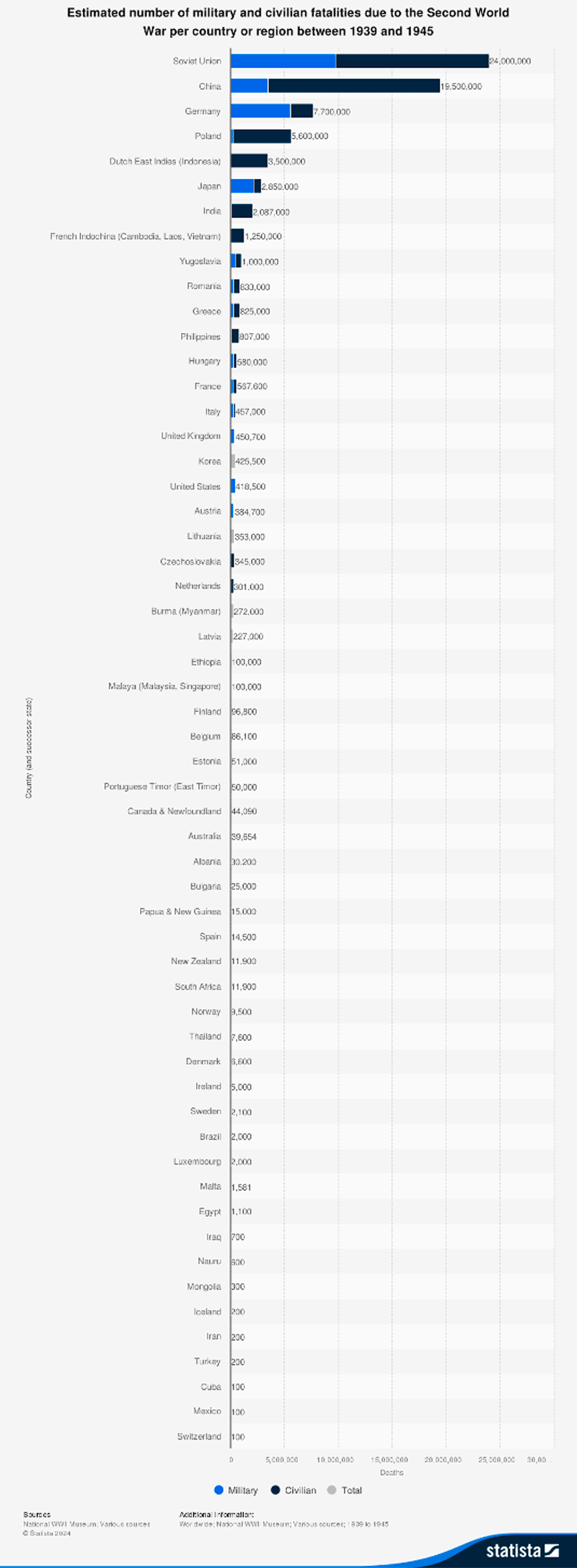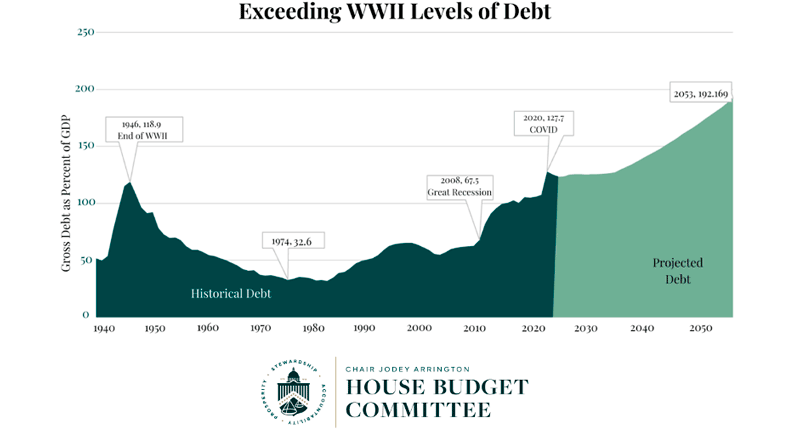The War of Two Worlds. Beginning
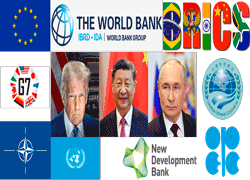 Despite the breathtaking pace set by President Trump, we should not lose sight of the big game: The hegemon is fighting for supremacy against a multipolar but heterogeneous world. – Tectonic thoughts on a game in which everything is at stake.
Despite the breathtaking pace set by President Trump, we should not lose sight of the big game: The hegemon is fighting for supremacy against a multipolar but heterogeneous world. – Tectonic thoughts on a game in which everything is at stake.
Introduction
The complexity of events is overwhelming. Many commentators focus on individual incidents and try to place them in an overall picture. However, many only seem to see this in a blurred way. This series of articles uses history and cold facts to try to identify the big trend with a broad brush.
What President Trump will either build or destroy over the next four years will have a rather moderate impact on the big trend. I recall a statement by Noam Chomsky that American presidents – Democratic or Republican – have had little measurable impact on the general thrust of American foreign policy.
I chose the title of this article deliberately: Not “World War”, but “War of Two Worlds”, inspired by the title of the science fiction novel “The War of the Worlds” by H.G. Wells, whose work, published in 1897, revolves around the attack of Martians on the United Kingdom.
In a world war, countries or groups of countries fight each other – today, however, two worlds collide whose respective textures could not be more different. That is why I call this conflict the “ War of Two Worlds”.
On the one side, we find the hegemon US, which dominates the Collective West as a colonial power. On the other side is a world that is multipolar and strives for independence from the rigid corset of the hegemon. The Global South unites 90% of the world’s population. BRICS is the organization that implements this counter-proposal of a growing number of countries of the Global South, which economically challenges and already surpasses the main community of the Collective West (G7).
As a result of BRICS’ strength, hostile statements are already being directed at BRICS. Donald Trump already made aggressive statements in December, before he was even in office. This is somewhat surprising given that the entire Western media never took this organization seriously, if they even mentioned it at all. Further proof that the Western media is completely unreliable and therefore worthless.
The idea that the BRICS Countries are trying to move away from the Dollar while we stand by and watch is OVER. We require a commitment from these Countries that they will neither create a new BRICS Currency, nor back any other Currency to replace the mighty U.S. Dollar or, they…
— Donald J. Trump (@realDonaldTrump) November 30, 2024
The United States of America occupies a hegemonic position within the G7 group of states, while the multipolar BRICS organization is led by China and Russia. It should be noted here that the BRICS states are not led in a dictatorial manner, but in a way that corresponds to the principles of a multipolar organization. It remains to be seen which of the two sides will prevail in the long term. It should be noted that this is a long-term process that will take many decades.
History regularly helps to understand tectonic shifts, as the behavior of the powerful never changes: The hegemon builds up its status, then expands its influence until its military and financial resources are no longer sufficient. It then defends itself against parvenus by any means necessary, only to go under. The thesis formulated by Mark Twain that history does not repeat itself, but merely rhymes, proves to be imprecise with regard to human behavior. People’s behaviour remains constant, while the consequences of the same actions can vary due to the different epochs of civilization in which these actions take place.
Many politicians, media and publicists seem to agree that the world is on the brink of World War 3. If this were true, we could expect a direct war between the leading powers of the US, Russia and China. I am not of the opinion that the current conflict will play out in this way and will try to put forward my view stringently with well-founded arguments in the third part of this series. However, this statement should not be taken to mean that we will not face bloody conflicts for a very long time, or that the bloodbaths already underway will end and no new ones will begin. I assume that humanity is in for a very gory time.
In this series of articles, I will use history to put the current situation in some order and then try to describe the current state of affairs as the starting point of this epic conflict, and finally try to anticipate how it will unfold.
In this first part, I describe the Collective West.
Situation before the World War (1914-1945)
In terms of analyzing the two world wars of the last century, it makes sense from my perspective to view the events of the First and Second World Wars as a single entity and not as separate incidents. The decisive factor that dominated these two conflicts between 1914 and 1945 was not the imperial expansionism of the German Empire from 1914 onwards or the drive for new Lebensraum under Hitler, but rather the demise of Britain as a hegemonic power, replaced by the US.
To this day, textbooks, history books and other publications in the Anglo-Saxon-dominated cultural area have largely agreed that the First World War was caused by the Germans and that all parties were sleepwalking into this conflict. Christopher Clark’s book “The Sleepwalkers”, which came onto the market a good 10 years ago, gives this theory of “naivety and stupidity” a new impetus. However, I have learned in life that results and analyses based on being surrounded by fools are regularly wrong. Although Clark’s book is written in a very entertaining and intriguing way, it fails to recognize that the First World War was in no way unintentionally unleashed by sleepwalking, but was coolly calculated – by the hegemon who did not want the sun to set on his empire. I still remember well when, during my student days in the US over thirty years ago, I dined with an elderly but humorous retired British officer. His bon mot of the evening:
«I indeed saw the sun set down on the British Empire.»
The British Empire had become too well accustomed to living at the expense of its rich colonies, became sluggish and thus lacked the hunger that the parvenu Germany, born in 1871, had at its disposal and set standards in terms of industry that the British had less and less to match. This development was reinforced by the development of the railroads, which made it foreseeable that the British sea trade routes would face competition on land (Berlin-Baghdad Railway).
This opinion was expressed by Halford Mackinder, a British geographer who is regarded as the first geopolitician, in his Heartland Theory (1904). This theory formed the basis for the clear geopolitical thrust of the British and later the United States. This approach was further developed by the US, first by Zbigniew Brzesinski and then by George Friedman, and today forms a core strategy of the US. I would like to refer you to two articles on our blog: “Anglo-Saxon geopolitical strategy – unchanged for 120 years” by Karl Eckstein and ‘The division of the world and society into good and evil’ by Wolfgang Bittner.
Friedman’s core thesis can be summarized as follows:
“The primary interest of the United States over the last century – in the First, Second and Cold Wars – has been the relationship between Germany and Russia, because united they would be the only power that could threaten us – and so we have to make sure that doesn’t happen.”
George Friedman
This is a highly significant statement and is very important for understanding the conflicts of the 20th century and also for understanding the current trend. We will come back to it.
The first part of the World War is unleashed (1914-1918)
At the beginning of the 20th century, the British therefore had a twopronged problem: (1) they could no longer hold a candle to Germany in terms of research, technology and industry and (2) they saw the sea routes they controlled being threatened by land routes to which they had no access.
Asserting themselves in peaceful, civil and fair competition was too strenuous for the British as hegemon. The interest of the hegemon is precisely not to have to compete with the rest of the world. The hegemon maintains its supremacy by playing on its privileges (enforcing its reserve currency [monopoly], controlling trade routes [monopoly], plundering its colonies, etc.).
To maintain these privileges, the hegemon regularly uses force. However, simply declaring war on the Germans was not elegant, because even at this point in world history, as an aggressor, one had an image problem, which became apparent after the First World War, when the German Empire, which had been declared the aggressor, was punished by Versailles as never before. Furthermore, as a hegemon, you like to let others – even allies and “friends” – go first when it comes to dying in war.
It was therefore necessary to arrange for someone else to start the war in order to be able to intervene as a “savior for the good”. Furthermore, this conflict should not take place on one’s own soil and, as already mentioned, the blood toll should be paid by others if possible.
France, which had lost the sceptre of world power to Great Britain a hundred years earlier and still considered itself important – as it still does today – offered itself as a provocateur, as the French still had major digestive problems more than 40 years after the 1870/1871 conflict, because the Germans not only defeated the French in this conflict, but humiliated them.
Germany, Austria-Hungary and Russia in particular behaved naively in the run-up to the First World War. The result was a devastating slaughter with 10 million dead. Although the British managed to make others pay a much higher price in blood, the British losses were nevertheless very high.
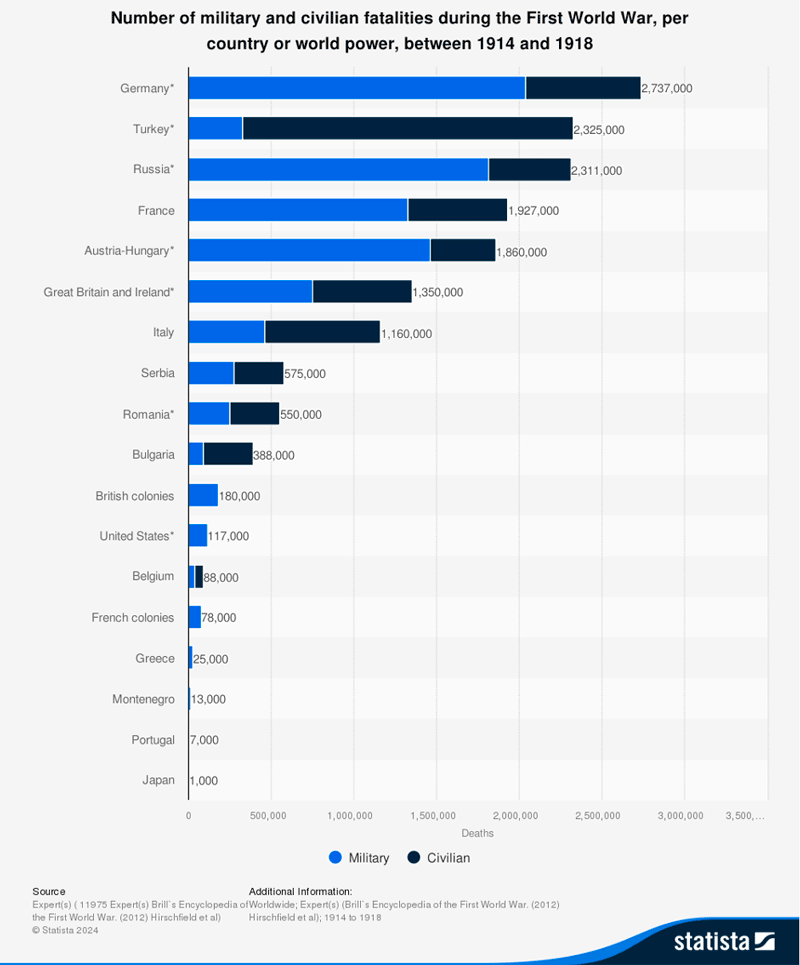
In the end, however, the British did not get their money’s worth. Although Great Britain was the largest country in terms of area of dominated territory and world population after the First World War (the British controlled 25% of the earth’s surface and the world’s population), this adventure heralded the decline of its hegemonic status.
The second part of the World War (1939-1945) – Hitler sponsored by the US and the British
The big geopolitical winner of the First World War was the US. The US waited until almost the end to join the war and earned a fortune during the conflict. All other parties were weakened and four empires collapsed: The German Empire, Austria-Hungary, the Ottomans and the Russian Tsarist Empire.
After a break of 20 years, this conflict continued in the Second World War. The US, which was on the verge of achieving hegemon status, financed Hitler in Europe and provoked the Japanese in the East.
The unsavory role of the United States and the British in the construction of the Third Reich was meticulously described by Guido Giacomo Preparata in his 2005 work “Conjuring Hitler – How Britain and America Made the Third Reich”. The German edition “Wer Hitler mächtig machte – Wie britisch-amerikanische Finanzeliten dem Dritten Reich den Weg bereiteten” was published in 2010 and is difficult to obtain. Interesting detail: The entry on Guido Giacomo Preparata has been deleted from Wikipedia – see pluspedia.org. An indication that he hit the bull’s eye with his book.
A book by Carroll Quigley (1910-1977), an American historian and professor of history at Georgetown University, had a similar fate. In his work “Tragedy and Hope: A History of the World in Our Time” (1966), he used internal documents from the Anglo-American elite to describe how they had significantly influenced the geopolitical order. The original edition of this work was scrapped, its publisher bought and then republished by the same elite in an appropriately toned-down version.
These “book murders” illustrate the lengths to which the elites are prepared to go to withhold the truth from the general public, even after more than 80 years, and also demonstrate the effectiveness of this approach. The vast majority of the world’s population is still convinced today that Kaiser Wilhelm II caused the First World War. In the West, hardly anyone is aware of the fact that Adolf Hitler would never have come to power without the support of the British and Americans. As a consequence, these two actors are largely responsible for the greatest bloodbath in the history of mankind. An extremely uncomfortable thought.
The result of the Second World War – or the second part of the World War – fully consolidated the hegemonic status of the US, with all but the United States losing, although the following casualty statistics from Statista.com should be taken with a grain of salt, but are very appropriate for showing the winners and losers of this conflict.
After 1945 – US as hegemon: wars and mismanagement
A dream start
When the US took over as hegemon can be viewed from different angles, but for the sake of simplicity I will take the end of the Second World War as the point in time: at that time, the US was the only major power without war damage, without civilian casualties, without significant losses of soldiers, with an industrial power that accounted for 70% of world production and an image as a savior. Furthermore, with Bretton Woods, the US had a monetary system that it controlled completely. The starting position could not have been better.
Operation Paperclip
However, the US also used dubious means to cement its industrial supremacy at the end of the Second World War. One of the secret programs called “Operation Paperclip” aimed to bring German scientists, engineers and technicians to the US. This included individuals such as Wernher von Braun, who later played a key role in the US space program. These scientists worked on projects such as rocket development (e.g. the V2 rocket, which became the basis for the later Saturn rocket). Von Braun used forced laborers from concentration camps during his career in Nazi Germany; thousands perished in the process. Instead of bringing him to trial, the red carpet was rolled out for him and his team in the US and he was showered with medals and honors for his role as the father of the Saturn rocket. However, Operation Paperclip was just the tip of the iceberg.
Germany was not only a leader in rocket science, but also in various fields such as chemistry, aviation and medicine. The US and the Allies wanted to exploit these innovations. Numerous patents were confiscated, in particular by Allied Control Council Directive No. 10, which provided for German scientific and technical achievements to be made available to the Allies. Millions of pages of technical documents and patents were transferred from Germany to the US. For example, developments in the chemical industry (dyes, plastics, pharmaceuticals) were taken over by companies such as IG Farben. The US also benefited from developments in the aviation industry, e.g. from the German company Focke-Wulf or Messerschmitt.
This transfer of know-how was part of a broader effort to dismantle Germany technologically, while at the same time using its knowledge for its own further development.
Wars, coups and endless misery
Since 1945, the US has been involved in countless wars, which it has caused directly or indirectly – here is a selection of the countries affected: Korea, Vietnam, Laos, Indonesia, Lebanon, Cuba, Congo, Dominican Republic, Cambodia, Grenada, Libya, Panama, Iraq, Somalia, Yugoslavia, Haiti, Kosovo, Afghanistan, Yemen, Iraq II, Pakistan, Somalia, Uganda, Niger, Ukraine. In addition, there have been countless CIA coups or attempted coups (e.g. Iran in 1953) and countless wars caused by the US (e.g. Iran-Iraq).
“Fairy tales do not stand up to fact-checking – and neither does this one.”
The behavior of the US is the behavior of a hegemon. It proclaims freedom and democracy in order to plunder entire parts of the world under this guise and completely destroy countries that refuse to march in step with the hegemon. It is a mystery to me that most people in the West not only believe the fairy tale of the friendly hegemon, but also internalize it – even today. Weren’t fairy tales meant for children? Because fairy tales do not stand up to fact-checking – and neither does this one.
No sustainable financing possible
These foreign policies cost the American taxpayer trillions and brought the US, or rather its people, absolutely nothing, except trillions in profits for the military-industrial complex.
The costs of the Vietnam War and the Great Society project under President Johnson led to the collapse of the Bretton Woods system just 26 years after the end of the Second World War (closure of the gold window by President Nixon in August 1971). See our article “BRICS – Series – Part 2”
Since then, the US has been printing money that it does not have and that is not backed by anything.
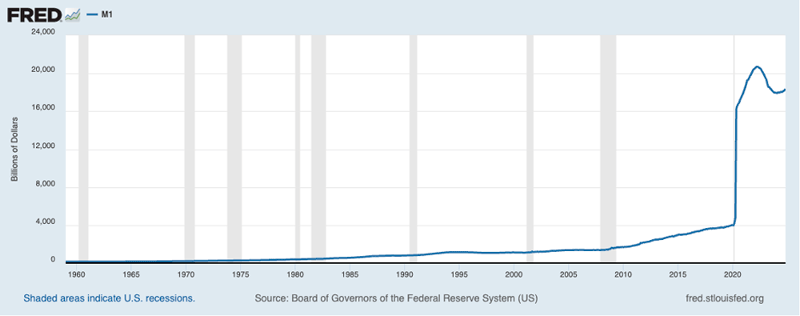
The result is a mountain of debt that can no longer be reduced under any circumstances. I have never seen a calculation or a plan on how to pay off these debts. It is not intended because it is not possible.
The current debt service alone, i.e. the interest payments on the ever-increasing debt, amounts to over one trillion dollars per year and rising. See our article “Trump threatens BRICS – for no reason. Diplomacy is different.”
The website Visualcapitalist.com provides an impressive graphic depiction of the world of debt.
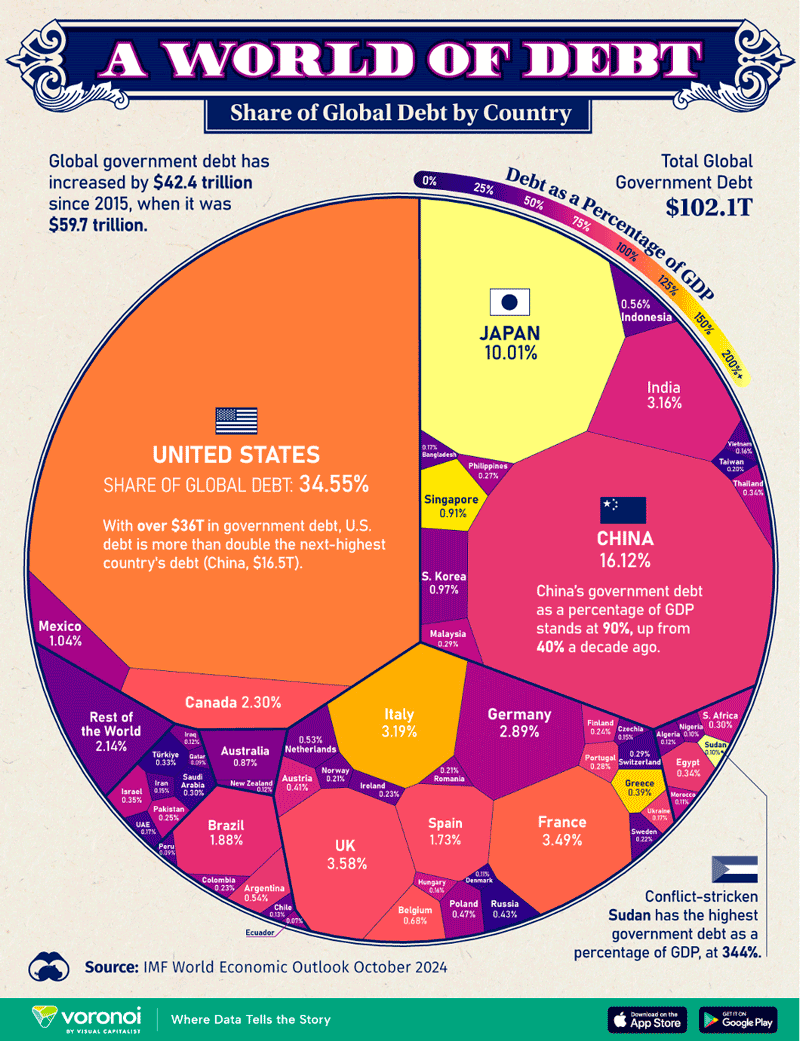
The official national debt of the US is horrendous and accounts for almost 35% of the global national debt (121% of the US gross national product). I use the word “official” because this figure does not include the so-called unfunded liabilities. This item includes obligations from Social Security and Medicare and amounts to a further 80 trillion US dollars. I would also like to point out that these figures only refer to the federal level. In addition, there is the debt of the federal states and the cities and municipalities.
The debt of the US – only the official debt at federal level – is already higher today than it was after the Second World War. The mountain of debt at that time could be reduced – although this was a feat of strength – because the US dominated the world industrially, financially and militarily.
Russia is financed on a sustainable basis
Russia’s debt is interesting in this context. According to Visualcapitalist.com, Russia accounts for 0.43% (US: 34.55%) of global government debt and 19.9% (US: 121%) of gross national product. This makes it the least indebted industrialized country in the world, with Russia being one of the few countries with assets that probably bring its net debt close to zero. How the Western media can speak of an economically unstable Russia in light of these facts shows hubris and ignorance.
The US colonial empire
What are the colonies of the US?
Most of the US’s partners and allies are nothing more than colonies. See, for example, our article on Germany “Germany – State without sovereignty in a waking coma”.
The colonial empire of the US can be roughly described as those states that make up the G7 (Germany, France, Great Britain, Italy, Japan, Canada, the US), the EU, as well as Japan, Korea and Australia. We call this world the “Collective West”. In my opinion, however, France is an exception.
The designation of these countries as colonies is linked to the premise that a country on whose territory troops of the hegemon are stationed cannot be described as sovereign. The Federal Republic of Germany is home to 40 US Army bases, Great Britain 13, Italy 7, Japan 15, Korea 59 and Australia 1.
France is an exception in this context. As an old colonial power that recently lost its last colonies in Africa, it shows that things can be done differently. In this context, it is interesting to note that Charles De Gaulle had the courage in the 1960s to force the Americans to vacate their bases on French soil. The basis for this sovereignty was the “Force de frappe” (French for “striking force”). This term stands for France’s independent nuclear armed forces. It was established during the presidency of Charles de Gaulle in the 1960s with the aim of securing France’s own deterrent capacity and strategic autonomy, independent of the US and NATO. French defense and security policy is largely shaped by this strategy.
In the 1960s, Charles de Gaulle was the first to recognize that the United States of America was acting fraudulently with regard to the Bretton Woods system, demanded the return of French gold and thus initiated the disintegration of this system. It can therefore be said that there were certainly times after the Second World War when European leaders were able to stand up to the US. One example of this is Helmut Schmidt’s successful defense against President Carter’s influence on the gas pipelines with Russia. However, Schmidt also supported the NATO Double-Track Decision (1979), which aimed to station medium-range missiles with nuclear warheads in Europe, which in turn made him appear to be a recipient of orders from the colonial master.
Not only the US, but also its colonies are broke and therefore dangerous
All countries in the Collective West already have their backs to the wall economically due to their mountains of debt: in the EU, debt in relation to gross domestic product is 83%; Japan’s debt mountain is a staggering 251%. In the past, the well-founded opinion was that a debt/gross domestic product ratio should not exceed 60% – this is also the case with the EU’s debt convergence criteria. Today, these rules seem to be deliberately overlooked, as the facts show a catastrophic picture. Perhaps some are slightly less broke than others, but from a geopolitical point of view this is semantics. Thus, we do not go into the details in this article, but refer our readers to above, where we have described some of the points – most notably the debt of the US.
Of course, the Western collective is trying to convey an image of strength through its political leaders and media and – especially through the person of Donald Trump – to create a mood of optimism. However, a superficial analysis of the economic facts shows that the images and messages conveyed are in no way justifiable. The following remarks will shed light on the danger of a cornered animal that unleashes additional forces through its own serious mistakes and thus poses a significantly greater threat. In the third part, in which the course and chances of the various parties in this great game will be discussed, the quality of the education systems, the technological level and its development, the willingness to work and so-called “soft factors” will be included in the discussion alongside the purely numbers-based economy.
Interim result
The Americans, as leaders of the Collective West, find themselves in a situation comparable to that of the British Empire before the First World War. Their own economy looks bad, American industry is a shadow of its former self and the followers and colonies of the hegemon are also in a pitiful economic state.
Added to this is the unstable domestic political situation of many allies (South Korea, the United Kingdom, Germany, Austria, France, Canada), as considerable sections of the population in many Western countries feel that they are being taken for a ride by the authorities. The lies that were presented to the populations in COVID times were probably the beginning and have considerably damaged the credibility of governments. The green revolution is no longer supported. This has to do with the credibility of its narrative and also with the costs, as the rest of the world – including the US – is turning away from it. Finally, the Woke movement is destroying freedom of expression, although Washington has announced improvements here – so it’s not always all negative.
The Collective West is therefore socially and economically anything but well prepared for competition or conflict with the Global South.
In the second part of this series, we turn to the other world – the Global South and specifically the main organization that represents this world economically – BRICS. In contrast to the pre-1914 period, this time the parvenu is not a country that wants to get to the top and aspires to become a hegemon itself. The situation is considerably more oppressive, because two worlds are colliding. The aggressor is not the emerging world – the Global South – but the declining hegemon – the US with its colonial power. History is repeating itself – unfortunately.
Peter Hanseler




